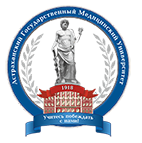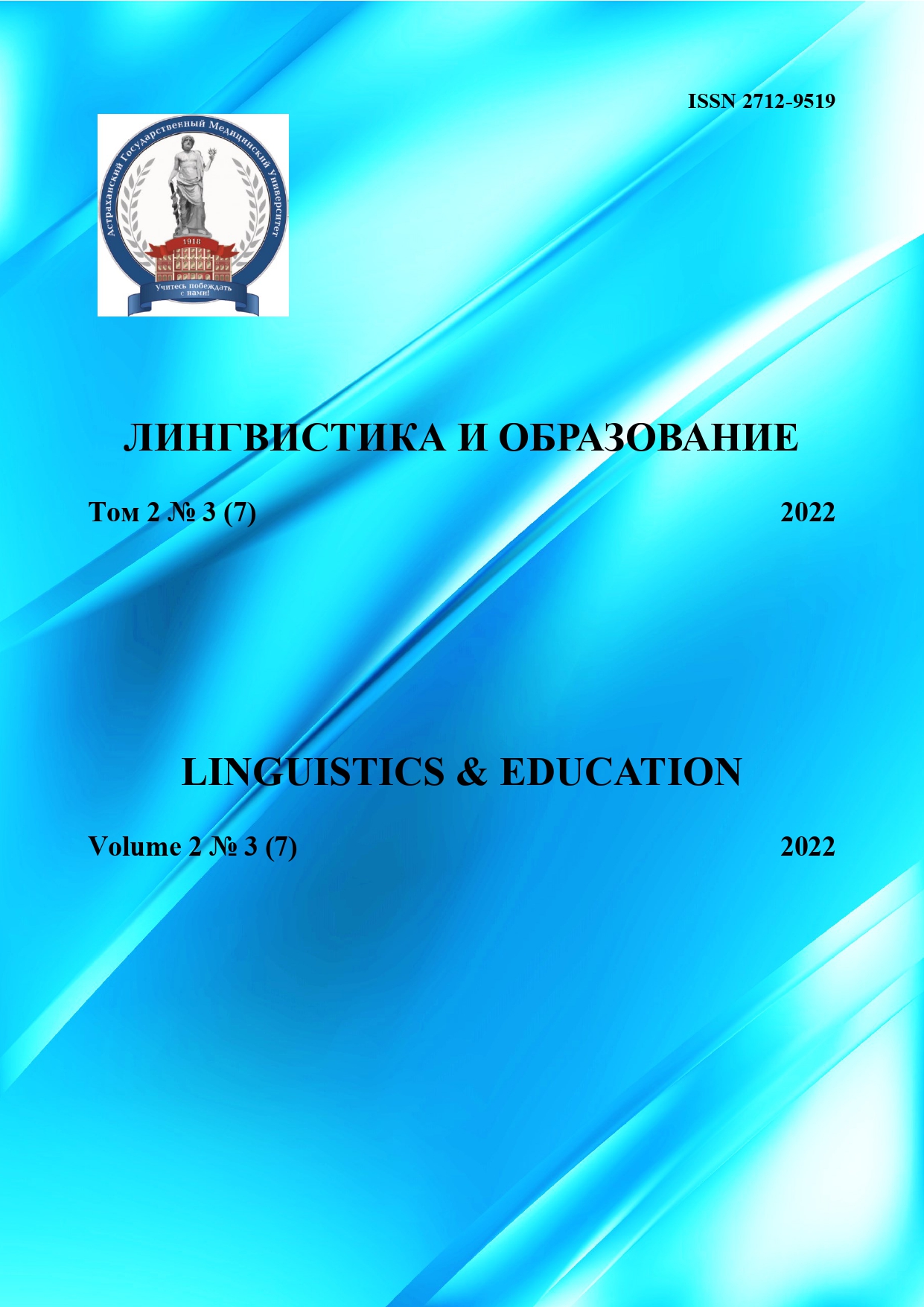Astrakhan, Astrakhan, Russian Federation
UDK 811 Языки естественные и искусственные
This article describes the concepts of “critical thinking”, given by different psychologists, and characterizes the basic principles and stages of critical thinking. The development of critical thinking is the most important condition for the successful professional activity of a medical specialist. The author of the article describes techniques and tasks used to develop critical thinking of medical students in the Latin language classes. It should be noted that every student in the group should have the opportunity to take part in the work. At the same time, it is necessary to create comfortable atmosphere in the room, excluding distrust, emotional and moral tension.
thinking, critical thinking, development of critical thinking, Latin language, comprehension
Introduction
According to the requirements of the Federal State Educational Standard, as a result of mastering the discipline, a student must form a number of universal and general professional competencies. Modern medical specialist must have not only professional characteristics and deep knowledge of his profession, but also a flexible mind. He must be able to adapt to changing circumstances, quickly respond to changes in situation, find new ways to solve problems, must independently acquire knowledge, competently work with information received from various sources, both in Russian and in a foreign language, be able to think critically, highlight the main thing and not use unnecessary information. Thus, the development of critical thinking of a future specialist is one of the main goals of modern education.
At present, several definitions of the term “critical thinking” are used in scientific literature. American psychologist Diane F. Halpern writes that critical thinking is aimed at obtaining the result (this is directed thinking), this type of thinking is directed at solving problems, formulating conclusions, probabilistic evaluation and making decision (it is characterized by controllability, validity and purposefulness), it includes the use of cognitive techniques or strategies that increase obtaining of result [Халперн, 2000: 22]. To J. Braus and D. Wood, critical thinking is focused on deciding what to believe and what to do, ... this is reasonable reflective thinking. In their book “The Development of Critical Thinking in the Lesson” S.I. Zair-Bek and I.V. Mushtavinskaya emphasize that critical thinking is the process of correlating external information with the knowledge available to a person, making decisions about what can be accepted, what needs to be supplemented, and what should be rejected [Заир-Бек, 2011: 5].
In these definitions we see that critical thinking is a directed, reflective thinking, including the use of cognitive techniques and strategies. In addition, S.I. Zair-Bek and I.V. Mushtavinskaya note that critical thinking is a complex thinking. To have it means to be able to: 1) correct, and sometimes refuse, one's own beliefs; 2) not only think internally, but also interact with other people (work in a team); 3) manage your emotions and feelings (it gives ways of active actions, including socially significant ones) [ibid, 2011: 5].
American professor David Klooster identifies five main principles of critical thinking [Клустер, http://testolog.narod.ru/Other15.html]:
1) independent thinking. Therefore, each student should have enough time and enough freedom to think about a question or a task, form his own point of view, and then discuss his opinion with other students and teacher.
2) information is the starting point, but not the end point of critical thinking. Students learn to perceive and retain in memory the basic knowledge, concepts and terms which are necessary to form their own opinion.
3) critical thinking begins with a question and highlighting of a problem that need to be solved. So, a teacher should formulate problematic questions for each topic, and use the method of moving from a general concept to its analysis.
4) critical thinking strives for convincing argumentation. A critically thinking person not only finds his own solution to the problem, but also argues his decision, underpinning it with reasonable arguments.
5) critical thinking has a social character. When we discuss, argue, exchange opinions, we clarify and deepen our own position. Therefore, in the classroom, teacher needs to use not only individual, but also paired, as well as group work.
The purpose of this article is to consider techniques and exercises that contribute to the development of critical thinking in Latin language classes.
Findings
It should be noted that critical thinking can be developed. For example, the development of critical thinking is possible during teaching grammar through analysis, comparison and evaluation of existing knowledge with a new, unknown topic. Basic model of the development of critical thinking corresponds to the stages of human cognitive activity – “Challenge – Comprehension – Reflection”.
1 stage – “Challenge”. New grammatical topic in Latin language classes must be introduced in relationship with the previous grammatical topic. In this case, the previously acquired knowledge for some students reaches the level of awareness, while other students receive new knowledge that can be connected with the existing ones.
2 stage – “Comprehension”. Translating the terms with the elements of new grammatical topic, students write down questions that arise during their translation. Then each student explains what helped him to make the correct translation of the terms. Here we have an element of introspection, as well as an exchange of opinions.
3 stage – “Reflection”. At this stage, students, thinking about new grammatical topic, correct their knowledge, systematize and generalize the material.
At each stage, various methods and types of work are used – individual work, work in pairs and in groups. It is important for every student to take part in this work. One of the main requirements in this case is the creation of comfortable atmosphere that excludes distrust, emotional and moral tension [Байдашева, 2018: 32].
We would like to describe the most effective methods of technology for the development of students’ critical thinking used in the course of practical classes:
1. “Mosaic of Problems” technique is used at 2 and 3 stages and develops the ability to generalize extensive material, to correlate existing information of the lesson topic with new information. For example, when we discuss the topic “Structure of anatomical terms and their translation into Russian”, students identify several key aspects of the topic, fix them on a piece of paper divided into several fragments, cut and distribute the fragments into several groups. Each group contributes answers to questions on a separate fragment, as a result of which all options are discussed and exact answers are formulated.
2. “Insert” technique can be used at any stage. This technique contributes to the actualization of independent activity of students, stimulation to search for new information, systematization of existing knowledge. For example, when you introduce the topic “Degrees of comparison of adjectives”, you can recall and write on the blackboard in a cluster form the already existing knowledge of the topic “Groups of adjectives”, which will be used as a base for learning new topic. At the comprehension and reflection stages, in order to resolve contradictions and expand knowledge we propose to study the content of the grammatical material and analyze it using the “Insert” technique. To do this, students make appropriate notes and then present information in 4 blocks: 1) What have you already known? (“+”), 2) What is completely new for you? ("N"), 3) What contradicts your existing knowledge? ("-"), 4) What remains unclear to you, on what issues would you like to receive more detailed information? ("?").
The use of these techniques contributes to actualization of knowledge. Indeed, in order for new information entering the brain to be assimilated, it must be recognized and comprehended by a person [6, с. 245].
Also, good result was achieved when tasks with elements of the game were used:
1. Compose the alphabet. Students of 2 teams have cards with letters of the Latin alphabet. The teams’ task is to arrange the letters alphabetically. The purpose of the game is to check the study of the alphabet, consolidate the material and develop the interaction of students in a team.
2. Divide the following words into five groups (according to five declensions). This task can be used as a basis for determining the scheme of five declensions of Latin nouns. Through discussion and analysis, students determine the signs of five declensions of Latin nouns.
3. Write combinations of words. Students have cards with nouns and adjectives. The task is to make terms, according to the rules of their agreement in gender, number and case. The task can be used both to test knowledge of the topic, and at the stage of introduction of grammatical topic “Adjective and noun agreement”.
4. To check knowledge of terms, the following exercises are effective – make a word using the letters, find words in a crossword puzzle, write as many words as possible starting with a certain letter.
For development of critical thinking, you can use project-based learning. In this method, first of all, the interests and individual abilities of a student are taken into account. In addition, such classes affect the emotional sphere, which increases students’ motivation; students get the opportunity to carry out creative work within a given topic, while they learn to think independently, find and solve problems attracting knowledge from different areas for this purpose [7, с. 61].
Conclusion
In conclusion, we would like to note that the basis for the education of medical students is the successful mastering of professional competencies and the development of the ability to solve various clinical problems, what is impossible without the formation of critical thinking and a non-standard approach to assimilation of information. At the university, critical thinking must be formed from the first year. So in future, a medical specialist will be able to find, collect and summarize factual material, drawing reasonable conclusions, improve and develop his intellectual and general cultural level.
1. Halpern D. Psihologija kriticheskogo myshlenija [Psychology of critical thinking]. - St. Petersburg: Publishing house “Piter”, 2000. - 512 p.
2. Braus Dzh., Vud D. Invajronmental'noe obrazovanie v shkolah: Rukovodstvo: kak razrabotat' jeffektivnuju programmu / perevod s anglijskogo [Environmental education in schools: A guide: how to develop an effective program / translated from English]. - St. Petersburg: NAAEF, 1994. - 499 p.
3. Kluster D. Chto takoe kriticheskoe myshlenie? [What is critical thinking?]. Retrieved from http://testolog.narod.ru/Other15.html
4. Zair-Bek S.I. Razvitie kriticheskogo myshlenija na uroke: posobie dlja uchitelej obshheobrazovatel'nyh uchrezhdenij [The development of critical thinking in the classroom: a guide for general education institutions]. - M.: Education, 2011. - 223 p.
5. Bajdasheva Je.M. Psihologo-pedagogicheskie aspekty polikul'turnogo obrazovanija kak chast' kul'tury prepodavatelja i studentov medicinskogo vuza [Psychological and pedagogical aspects of multicultural education as part of the culture of a teacher and students of a medical university] // Materialy nauchno - prakticheskoj konferencii s mezhdunarodnym uchastiem «Psihologicheskoe i pedagogicheskoe soprovozhdenie studentov vuza v sovremennom sociokul'turnom prostranstve» [Proceedings of the scientific and practical conference with international participation “Psychological and pedagogical support of university students in the modern socio-cultural space”]. - Astrakhan, 2018. - Pp. 32-37.
6. Lukojanova T.V. Medicinskij termin kak kognitivnaja edinica, otrazhajushhaja uporjadochenie special'nogo znanija [Medical term as a cognitive unit reflecting the order of special knowledge] // Terminy v kommunikativnom prostranstve: materialy nauchno-prakticheskoj konferencii s mezhdunarodnym uchastiem «Diskursologija, terminologija, jekologija jazyka v sovremennoj lingvistike» (11 maja 2018) / otv. red. S.I. Madzhaeva. [Terms in the communicative space: materials of the scientific-practical conference with international participation “Discursology, terminology, language ecology in modern linguistics” (May 11, 2018) / responsible editor S.I. Madzhaeva]. - Astrakhan: Publishing house of the Astrakhan State Medical University, 2018. - Pp. 244-251. URL: https://elibrary.ru/item.asp?id=35628334
7. Lukoyanova T.V. Metod proektov, kak odin iz novyh metodov v pedagogike / T.V. Lukoyanova // Sovremennye problemy nauki i obrazovaniya. - 2009. - № 6-1. - S. 61. Rezhim dostupa: https://www.elibrary.ru/download/elibrary_12966500_38535287.pdf (Data obrascheniya: 2.09.2022)










